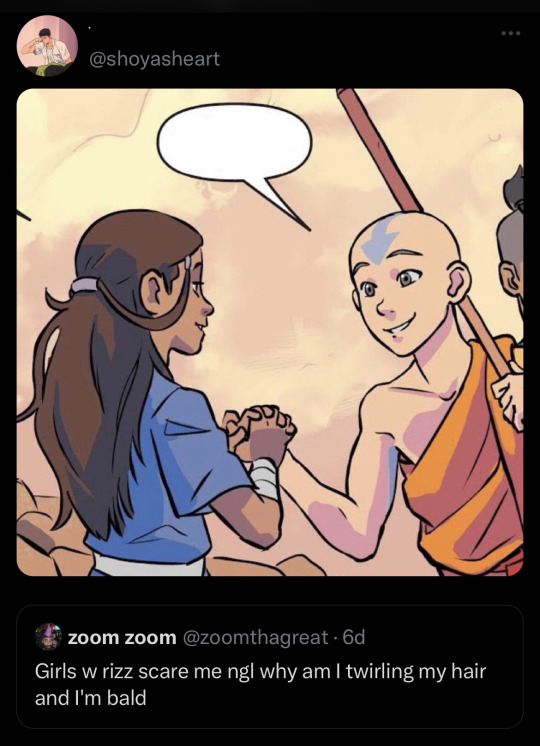Text
you start watching dungeon meshi and you see how marcille acts and it's like "great... another show where the girl character is fussy and dramatic and easily grossed out compared to her male counterparts :///" and then you continue watching and meet other female characters who are not at all like that and it's like "ah, she's not like that because she's a girl, she's like that because she's italian"
37K notes
·
View notes
Text

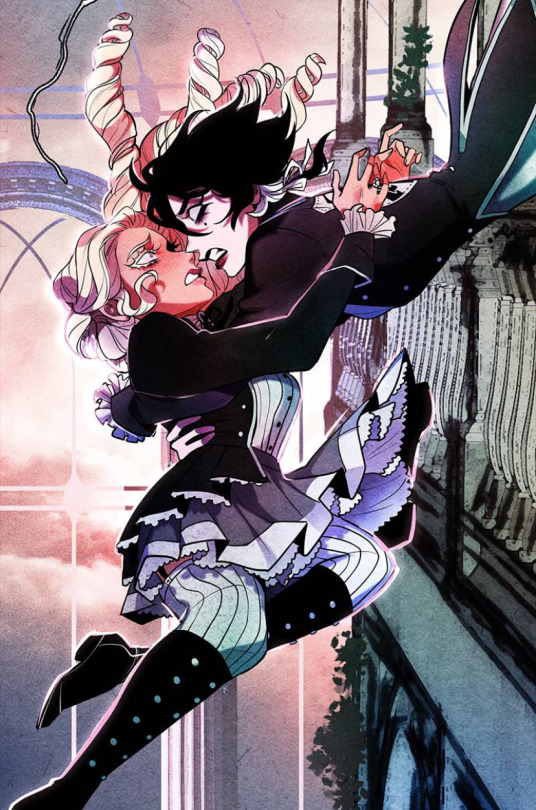
idk if this counts as parallels but they look similar 🤫🧏♂️
552 notes
·
View notes
Text


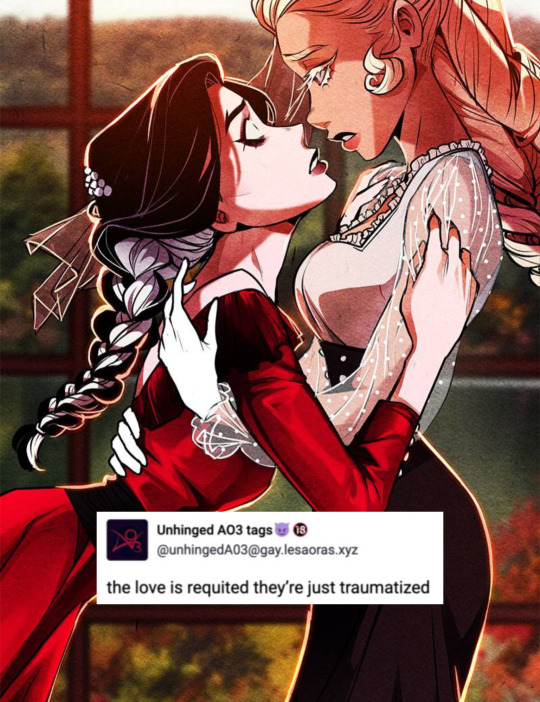

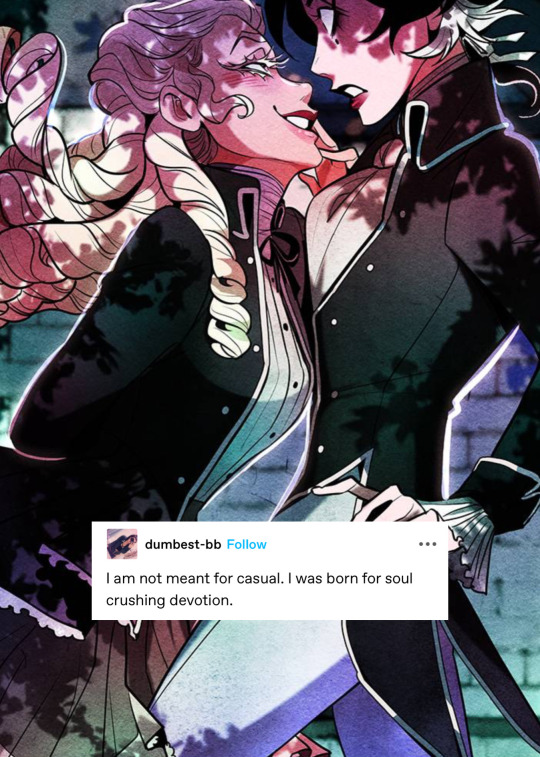





Nevermore fandom: Oh yeah divorce arc let’s go!
The divorce arc: [is still going on since it hasn’t even been 24 hours since Lenore found out about what happened to Duke and White Raven can’t manage to effectively communicate to save their lives]
Nevermore fandom: Wait no-
<(44/??)
[read more]
+Bonus!

728 notes
·
View notes
Text
the heroine of rebecca is so fucking funny because she will just go off on a tangent where she imagines what will happen if she does something and it will be three pages of her going into the most DETAILED FUCKING DAYDREAM you have ever heard, complete with subplots and dialogue, meanwhile in the real world she has not moved or said anything she's just sitting on the floor catastrophizing while everyone around her is carrying on as normal because they haven't noticed she hasn't contributed to the conversation for the last 10 minutes. the guy she likes will tell her to her face "i am hanging out with you because i like spending time with you, i am not playing games or being nice or speaking with any double meaning" and she's like "sounds fake." she starts a small fire in a hotel room while her fiancé and employer are in the NEXT ROOM talking about her because she's convinced she'll never live up to her man's ex and she wants to take her mind off it. her best friend is a dog. she tries to climb out a window to avoid meeting her in-laws. girl is mentally unwell! 10/10 anxiety representation.
667 notes
·
View notes
Text
Lenore Vandernatch: the rogue, the gothic heroine and the courtly knight. A review of archetypes
Okay, after going over my notes, here we are again. In case you don't know what this is all about, here is the first of these posts where I'm doing a review of some of the archetypes that Annabel and Lenore seem to be taking notes on.
Just so this doesn't end up being another 3000 word post, let's get started.
The Rogue
In 1554, the first written version of "El Lazarillo de Tormes" was published, the foundational work of what would become known in Spain as the "picaresque novel": stories centered on the rogue, a poor rascal who uses trickery to ensure his survival.
At this stage of the game, we have rogues in a variety of flavors and colors. It would be difficult to make a comprehensive list, so let's talk about these characters in general.
The first thing to note is that rogues are, by definition, outsiders. In the traditional picaresque, the rogue is simply someone from the lower classes, but as this archetype has grown, it has become less about class and more about criminality.
Yes. Rogues are criminals: thieves like Robin Hood, swindlers like the Lazarillo...
Fraud, arson. You name it.
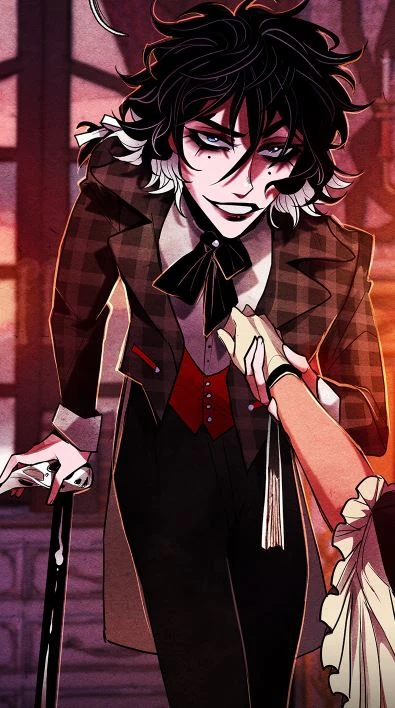
Getting back to the issue of the rogue as an outsider, they may have been one from the start, or they may have become one after attaining their criminal status. Regardless of the reason, these people operate outside of the law, the authorities generally give a shit, and, depending on your rogue flavor, may even actively fight against it.
One thing to note here: this goes a bit beyond Lenore's rebellious attitude. Like a good rogue, she derives enormous personal satisfaction from the thought of getting her way. The world has turned its back on the rogue, so the rogue will not hesitate to turn her back on the world.
In Lenore's case, this attitude of throwing all authority to the wind and actively ignoring any rules imposed on her is a mixture of personality and trauma. In the flashbacks, we see that Lenore has always had a certain disdain for protocol and formalities, but of course, after being locked up for at least a year because the rules of the society she lives in have decided to make her an outcast for her brother 's death, she no longer finds any reason to listen to what they have to say to her. The rules will never go beyond the feeling that she has agency over her life.
From this follows the methods of the rogues: opportunism is one of their hallmarks. Ingenuity, cunning, and creativity are common traits among these characters, something that is usually tied to their status as outsiders and criminals; they don't care about rules, so they think outside the box, either because they are highly intelligent or because they lack common sense.
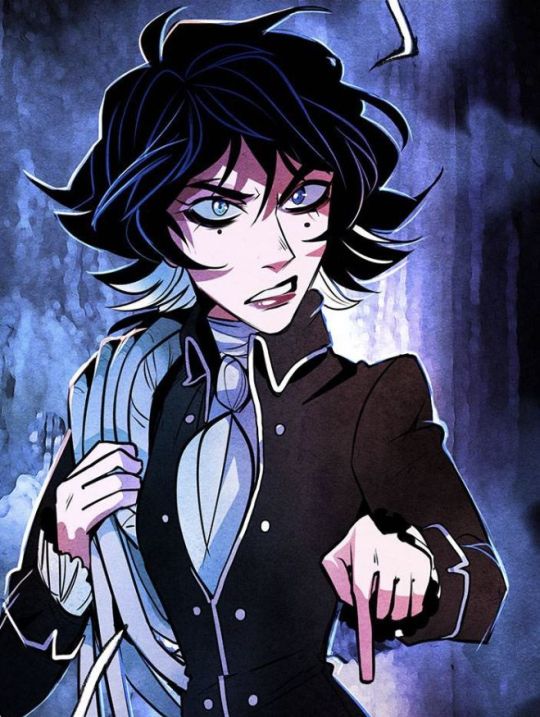
Maybe both.
So, yes, when Annabel tells her dashing rogue, she's not wrong in the least. But there are more interesting things to look at here
The Gothic Heroine
When some theorists say that Gothic heroines are bland and uninteresting characters, it's...true. But there's a reason for that, so let me get that out of the way for a moment: the image of the maiden in this period is used as a symbol of purity, chastity, goodness, and her corruption, death, or disease works on both a literal and metaphorical level. It is like when you see grotesque religious images in horror movies, there is a powerful and disturbing charge in the idea of seeing something "pure" destroyed.
So the thing about gothic heroines is that, at worst, they are not characters who contribute to the story they are in, but tokens, quasi-sacred representations who are there to die, get sick, or fall victim to a villain who might sexually harass them. Yes, unpleasant.
But good gothic heroines (besides possibly having tuberculosis) are characters with arcs related to corruption, especially mental corruption. And this is where it gets interesting.
But we go from less to more. In her flashbacks, Lenore's physical appearance is almost exactly that of a gothic novel protagonist: pale, almost cadaverous, slender, languid in her movements (because, in this case, she's drugged a significant percentage of the time), and long hair.
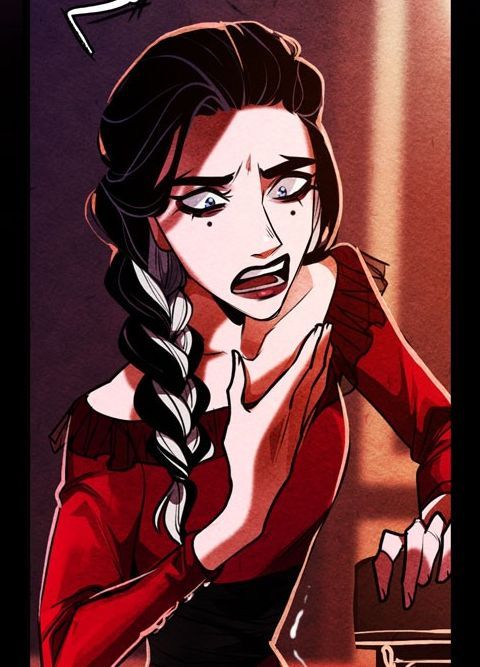
Her background in this part of the story, like that of the best gothic heroines, is one of mental corruption: she is here, imprisoned, withering and losing her mind, giving in to despair. There are those who point out a rather strong resemblance between the scene where Lenore tears the flowered wallpaper from her room and the short story The Yellow Wallpaper by the writer Charlotte Perkins. And although this story is not gothic, it definitely retains the most important trope of the genre.
Another element in which we can find Lenore is in the Gothic ballad of the same name, written by Gottfried Bürger in 1773. This poem tells the story of Lenore, a girl condemned by narrative for blaspheming against heaven after the death of her beloved, who is later visited by the Grim Reaper himself to take her to him.
A heartbroken woman committing blasphemy in the name of a lost love? I wonder if that sounds familiar.
And if I had to point out one particular gothic heroine with whom Lenore shares important similarities, it would be Laura from Carmilla.
With the first, she shares two very important things: isolation and a penchant for women who can murder her, a complicated relationship with a gothic vampire.
Laura lives in complete isolation from the world, with the only company of maids and her father; within the first few chapters, we know that she can barely remember the last time she had the company of a woman her own age. Like Lenore in the flashbacks, Laura is something of a secret, hidden from the world (though for less horrific reasons).
And that isolation is broken by the arrival of an elegant, almost supernaturally beautiful upper-class lady who almost kicks in her door with a "Hi, I want to be friends. You'll like me."
Both Laura and Lenore are not afraid of the vampire, though they are not unaware of her strange behavior and will raise a puzzled eyebrow at her promises of affection, as well as her obvious tendency to insist on a fucked-up secret that they are in the middle of and can't share. Another important detail is that both characters have a certain difficulty in describing their feelings as romantic: both are very obviously obsessed with this mysterious lady who has come to interrupt their loneliness, but Laura never fails to refer to Carmilla as her "friend" (a behavior that the modern reader may interpret, with more than fair reason, as comphet), and Lenore is little more than that, at least until the mansion arch where the shingle falls on her.
Last but not least, just as Lenore is treated as "crazy," there are several events in Laura's life (such as her first encounter with Carmilla when she was a child) or that occur throughout the novel that are dismissed by those around her as her being a little touched in the head.
The courtly knight
Here it is necessary to make a distinction: knights are a far-reaching figure, but before and during the Middle Ages they mainly starred in two types of stories: the canta de gesta (which was intended to tell great deeds of inspiration for certain peoples, such as the Song of Mio Cid in Spain or the Song of the Nibelungs in Germany. This last one is the best Canto de gesta in history, I do not accept arguments) and the Novel of chivalry or courtly (focused on the individual story of the knight and introduces elements of the court).
What is the main difference between the knight of the canto de gesta and the knight of the court? Well... the latter is much more horny. And we are talking about Lenore, so you have until the end of this paragraph to imagine which of these knights we are talking about.
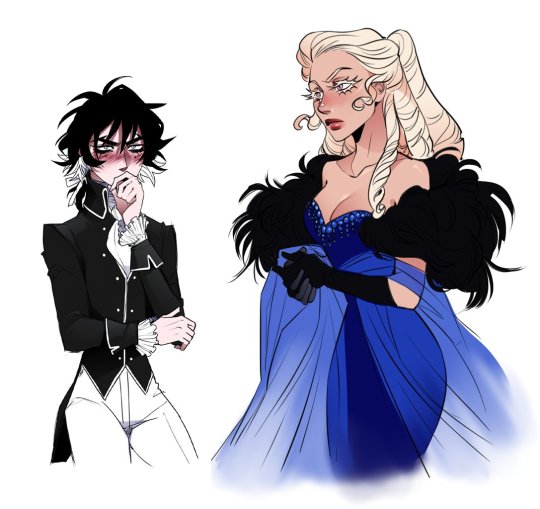
The first thing to keep in mind is that the Courtly Knight has a pretty strong moral compass: nobility, mercy, loyalty, and honor are values they firmly believe in; these characters are heroes, and that means that while they are not perfect, they represent ideals that are considered important in this time. And we're talking about vassalage, so you get it.
This is the first thing Lenore has in common with the knights of the court: her strong sense of morality. Yes, she's not afraid to play dirty like a rogue, but she's pretty clear about what things are important to her in that regard, and she's willing to uphold those ideals even in the context of Nevermore, which actively encourages its students to kill and betray each other.
However, the personal agendas of these knights have one important thing in common: the conflict between their own desires and their duty.
What are those desires? Well...

Good courtly knights usually have to choose between their love/sexual interests and where their personal loyalties lie, which, due to the era in which these stories take place, are usually their feudal lords or even kings.
We already established that Lenore doesn't give a shit about authority, but her personal loyalty is to her friends. And this is where it gets tricky for her: So far in the comic, Lenore has kept her relationship with Annabel a secret from her friends, and she has kept the fact that she wants to save her friends a secret from Annabel. A conflict that may eventually blow up in her face, and on the face of it, really befits a courtly knight (though if she were a real one, the Misfits might ask her to kill the Deans or something in exchange for accepting her relationship with Annabel).
To continue with this, we need to stop for a moment and talk about another little thing: courtly love. There are many definitions of it, but my favorite is the one that defines it as an attempt to reconcile mystical love with eroticism. Fun fact: these stories were written in the Provençal language, something that would associate romantic tropes with "vulgar language".

In any case, courtly love usually speaks of the beloved maiden as an idealized object, a figure who inspires an almost religious devotion. And the most recurrent theme within courtly love is what is called "love from afar": it focuses more on the journey in search of the beloved than on the couple's relationship as such (this journey can be literal or metaphorical), the knight has symbols associated with the pilgrim, there is a certain hatred of the image, the maiden is seen as an almost religious figure, and...
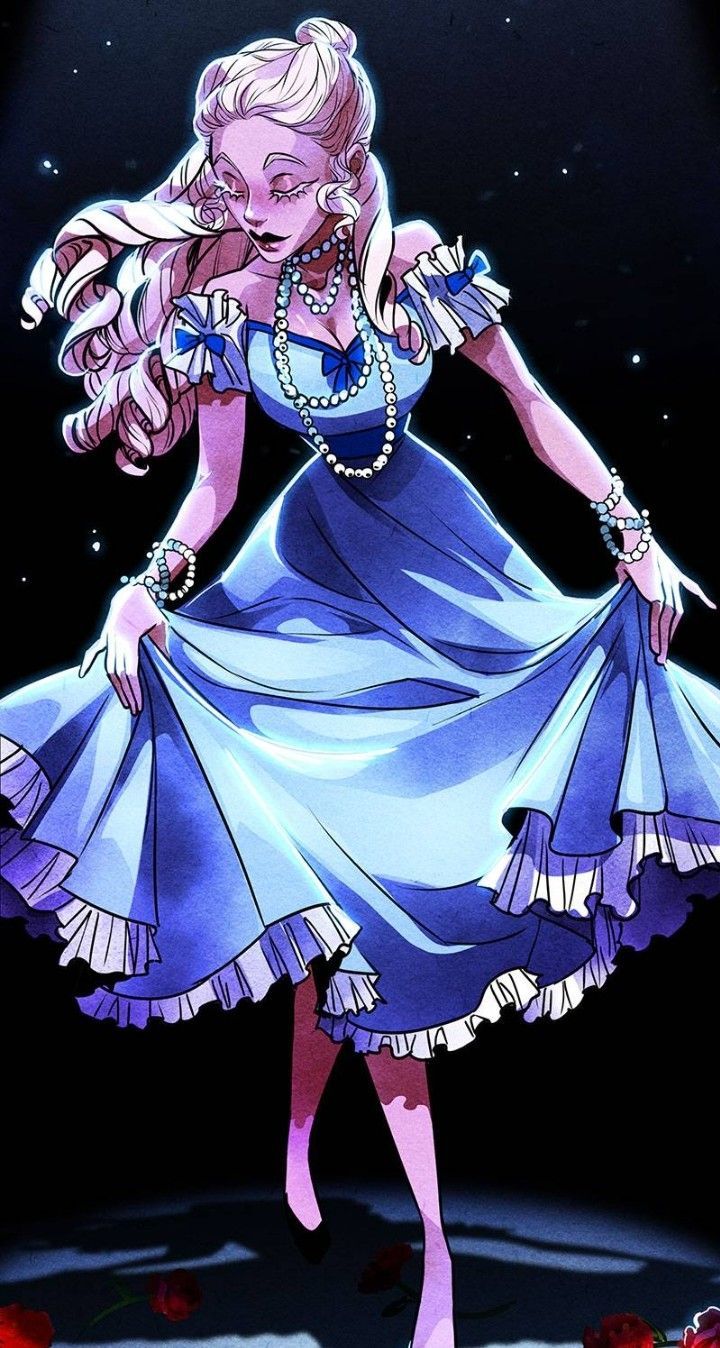
Yes, the color associated with the so-called "love from afar", specifically with the beloved maiden, is damn blue.
Now that we've got all that out of the way, it's time to break down why Lenore fulfills some of these things and why she doesn't.
Going with the tropes that are fulfilled, we can say that Lenore is on a more or less metaphorical journey. A journey to recover her memories and her identity. One at the end of which her lover waits for her "until the abyss claims them both".
Like a knight, Lenore is willing to make great personal sacrifices in pursuit of the things she cares about: she is willing to die for the people she cares about (the misfits) and for her lover (Annabel). The Living Long Thing is something the Knight don't know about, and since Lenore is in Nevermore, apparently neither does she.
With all that said, it's worth noting the biggest difference: courtly love features relationships based on vassalage and a huge power differential. Something that does not happen here. No, Lenore calling Annabel "my liege" doesn't count.

To explain this further -and to summarize, because it's a subject that bloody books have been written about-t he relationships in courtly love have two different levels of power: the knight must perform feats to be worthy of affection, and the maiden is little more than a prize to be won.
This unbalanced power dynamic is something that simply does not exist in the White Raven: an important part of their relationship is that both are equal in charisma, intelligence, and resourcefulness. The unstoppable force and the immovable object. Annabel is as willing to die for Lenore as she is for herself, and Lenore would probably go into berserker mode if anyone dared to treat Annabel as a prize.
Yes, you could argue that the balance of power is a bit weighted toward Lenore because Annabel is willing to make sacrifices for her that Lenore wouldn't make because she has some, you know, morals. But I think that has more to do with Annabel's character than her relationship with Lenore (that's another analysis I have a pin for when the season is over).
Conclusions
If the archetypes that Annabel seems to take note of are all quite related, Lenore, on the contrary, is much more like a mosaic: these characters have little in common and some (like the Rogue and the Knight) directly contradict each other. This woman is chaotic in her conception: opportunistic and rebellious as a rogue, pious and with strong values as a knight, and condemned by the narrative as a gothic heroine.
Another thing that stands out is that two of these three archetypes are traditionally male characters. Personally, I don't think Lenore is "like a man": her entire background and personal history is meant to work in terms of her status as a woman in the time period she lives in. She can do all the shit these male heroes do and better (though the hc that Lenore is somewhere on the non-binary spectrum is not a reading that conflicts with that).
And I use the word "hero" because another detail stands out here as well: yes, many of these characters are not only often the protagonists of the stories they are in, they are heroes within their historical periods and literary movements.
I'm going to do a third part of this comparing Lenore's archetypes to Annabel's because, believe me, there's some really crazy stuff to unpack there.
130 notes
·
View notes
Text
Annabel Lee Whitlock: The Hypocrite, the Vampire and the Femme Fatale. A review of archetypes
Good news: I'm on vacation.
Bad news: I'm on vacation.
And that means rest. A positive externality. But on the other hand, it also means that my brain, which is constantly thirsting for stimulation, has lost eight hours of activity a day that it has to fill with something. You know what happens to orange tabbies who suddenly become quiet and behave as if possessed by all the demons of Ars Goetia? Well, sort of.
So my brain in need of stimulation decided to dust off my college notes and talk about archetypes, because it's a thorough enough job to keep me away from climbing walls or checking random stuff on the Internet for 10 hours a day.
What is an archetype?
Just to make sure we're all on the same page, an archetype (a "type character") is a writing model that describes a role and has certain characteristics.
The term was coined by Honoré de Balzac, a French writer obsessed with what he called "micro-history. His life's work, "La Comédie humaine", is a massive collection of more than 80 novels, which, when read, will give you more information about that historical period than any theoretical book on the subject.

You may not know this sir or the protagonist of "Illusions perdues", but you do know the archetype that Lucien Rumempré represents: a young from the provinces, full of dreams, who moves to the city only to discover that the lights are there to dazzle and distract from the misery.
But at the same time, the characters that come to mind are likely to be very different from the good Lucien. This is because the archetype is a different construct from the cliché.
If I had to explain the difference, I would say that the cliché is a recipe, while the archetype is a mold.
If you follow a recipe, you will always get results that are very similar, even if you make small variations in the recipe. But if you have a star cookie cutter, the contents of the cookies can be quite different: no one would dare say that a chocolate chip cookie tastes the same as an oatmeal cookie or a gingerbread cookie. Even if all three are cut in the shape of a star.
So I'm going to do a little review of the archetypes that Annabel notices. The differences, the similarities, and let's see what comes out.
The Hypocrite
Not "hypocrite" in the sense of a personality, but in the sense of a way of behaving in the world: The Hypocrite is a character whose way of relating to the world is a pantomime, whose role is to build themselves up to fit into a system (which, by the way, they despise). If they don't have what you want, they will at least pretend enough to make you think they do. Usually for personal gain.
The founder of this archetype is Julien Sorel, the protagonist of "Le Rogue et Le Noir", the most famous work of Stendhal, one of the most prominent writers of the literary realism founded by Balzac.
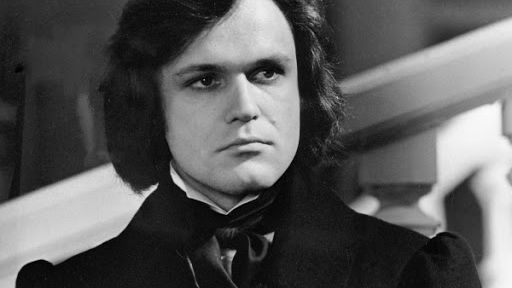
Julien is this poor boy, but smart enough to memorize the Bible, which makes him seem educated enough to get him a job as a tutor in a rich house, and eventually a priest's cassock.
A more modern example is Nick Wilde from Zootopia. This fox has decided that if he alone can be a con man, he will be one, though he desperately wants someone to see him as an individual beyond that. He hates the system that condemns him, but he wants to be a part of it and will play by the rules he is given in order to profit.

Annabel, like Julien and Nick, has built her entire identity around being what is expected of her, in her case a perfect Victorian high society lady. Something that has given her a tremendous amount of knowledge about how people move in such circles. And from her point of view, people are the same everywhere (Miss Marple would be proud of her).
And in this oppressive context that fosters an environment where people kill each other, she knows what currency to give in return for loyalty: people will look for a leader, someone competent, someone who knows what they're doing.
Annabel has no idea what's going on, what awaits them outside the Nevermore gate, or even if there's a way to escape. But she can pretend to know. The quietest person in the room wins, and she's the one who takes the prizes to achieve her goal. The performance is justified as a means to an end.

Another thing that characterizes stories with a Hypocrite as a relevant character is the exploration of the consequences of this lifestyle: identity is consumed by the role, the line between actor and character is lost, and the Hypocrite is often faced with the reality that they have put so much of themselves into the character they are playing that once it is exposed, there is nothing underneath, or at least nothing worth saving.
In Annabel's case, this is expressed in her utter horror at not being trusted by Lenore. She puts her hypocrisy at the disposal of her lover and comforts herself with the reward of her affection, but Lenore's love for her is the only thread that binds her own identity: that Lenore does not trust her means that the role has completely consumed her, the complete confirmation that she, as an individual, is no longer a disturbed poseur.

Related to this point, we have the final transversal line in the conflicts that Hypocrites tend to have: loneliness. When all their relationships are based on a carefully rehearsed performance, the Hypocrite knows that they are alone in the world, that no one really knows them, and they are usually so deep in the role by this point that they don't want to (or can't) leave it. The longing for honest relationships overlaps with their self-destructive tendencies.
As much as Annabel insists that it's her and Lenore against the world, that her life is meaningless without Lenore, and that she is enough, these phrases indicate that Annabel is painfully aware of how she is perceived by others, and though she tells herself that Lenore's love is all she needs, it seems more like a mantra to keep her sane than a reality.

As you may have noticed, the main difference from the usual Hypocrite is that Annabel has Lenore. A bit like Nick has Judy. But Nevermore is a story that takes the psychology of its characters much more seriously, so while Nick just needs someone to reach out to in order to form honest relationships, Annabel passes because she has no fucking idea how to form an honest, healthy bond.
That Annabel is extraordinarily self-destructive, emotionally dependent, and so afraid to step outside the box she knows so well are, in this light, natural consequences of the Hypocrite lifestyle.
The Vampire
Here we must make a leap to another movement: during the Romantic period, the Gothic novel was at its best, and it was Edgar Allan Poe who squeezed out the last drops of what this genre had to offer.
Now, looking at the bibliography, Annabel does not have much in common with the gothic heroine (that is something Lenore takes care of), neither on an aesthetic level nor on a value level. To find her in the works that inspire her, one must look in a slightly different direction: the female vampires of gothic fiction.
Aurelia ("Vampirismus" by E.T.A. Hoffmann), Carmilla ("Carmilla" by Sheridan Le Fanu), Clarimonde ("The death woman in love" by Théophile Gautier), the vampire in the poem "The Metamorphosis of the Vampire" by Baudelaire, the three vampire women, and Lucy ("Dracula" by Bram Stoker).
All these characters have something more in common than their fangs: they are beautiful women capable of making anyone who sees them fall completely into their arms, as opposed to their role of making the one they have chosen as their prey "fall".

The Gothic vampire is practically a succubus, but much less sexualized than one might think. Although many of these works, with the exception of the poem by the good Baudelaire (an author who should be fed separately on these matters), spare no pages in describing how beautiful they are, neither do they overly sexualize them, nor are they particularly flirtatious: even Clarimonde is dedicated to simply being there and letting her presence alone do the work.
This is something Annabel shares with the gothic vampire: though physically gorgeous, the framing in the comic doesn't tend to focus on her as an object of sexual desire, her beauty is highlighted, but in a way that is more akin to an ethereal or unattainable entity.
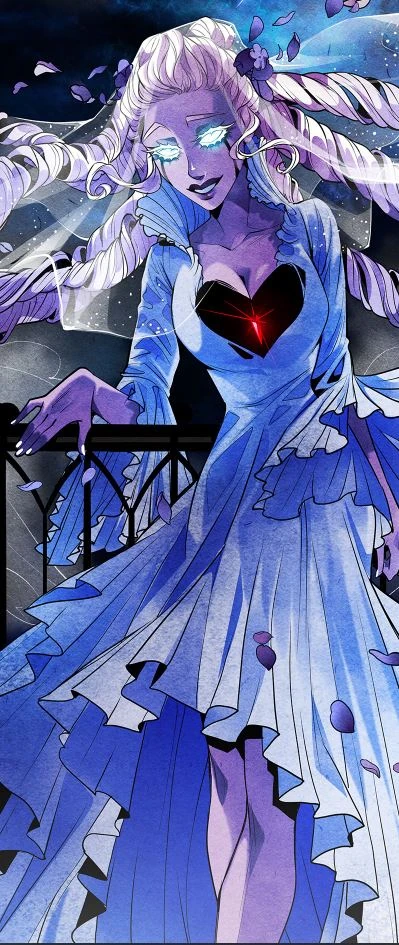
This is due to a mixture of two things: the Gothic novel is steeped in Catholic puritanism, and even if it is to present a villain who uses her attractiveness as a weapon, the erotic component is subtly exposed, and the vampire's angelic beauty offers a contrast to her status as an antagonist: beautiful on the outside, insidious on the inside.
This is another thing Annabel has in common with the gothic vampire: she is aware that her appearance gives her a haughty, elegant, and dignified air, identifiable enough to earn nicknames like "Queen" or "Queenie," and she knows how to capitalize on it. This contrasts with the darker parts of her personality.
Another thing that terrifies romantics about vampires is that these fangirl succubi possess a quality that makes us 21st-century readers raise an eyebrow because it's supposed to make us uncomfortable: a deep, honest, and sincere willingness to be affectionate.
In context, this makes sense: the vampire is a representation of sin, temptation, and lust. So their affection is something that leads the object of it away from the path of morality (this is the 19th century, this is really important).
I understand that because of the vampire's role in all of this, she is a devoted lover. Incredibly devoted, in fact: Clarimonde is Romuald's sugar mommy (no, I'm not kidding, I'm not exaggerating either), and Carmilla never stops showering Laura with affection and attention, satisfying this girl's craving for companionship after living in isolation.
Annabel does something similar: there is a genuine interest on her part to reach out and connect with Lenore, and in scenes like this, she goes out of her way to show her that she is an amazing person in her own right, rather than being her brother's shadow.
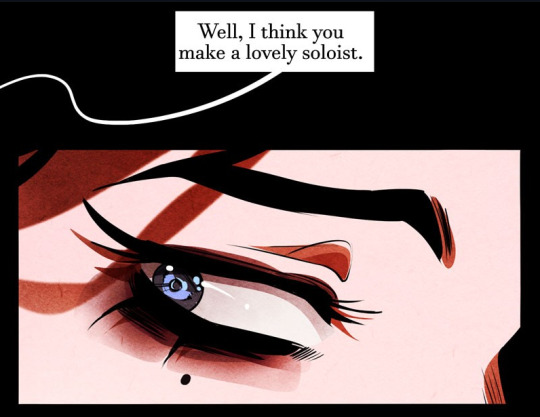
All kidding aside, I think of the archetypes I could find to analyze Annabel, this is the one that fits her best, even though she is not, well, literally a vampire. She seems to have several things in common with Carmilla in particular.
The Femme Fatale
We all have a more or less clear idea of what a femme fatale is: this extremely attractive, sexually active, badass woman who is there to make the male character's life miserable and has a 50% chance of smoking fine cigarettes with a cigarette holder. This is…partially true, but also highly inaccurate.
Although these characters can be traced back much further in mythology, this archetype gets its name and very specific form from Raymond Chandler, the founder of the noir novel. I'm not going to go into too much detail on this topic, as entire books could be written about it, so let's just focus on what's important.
The thing to understand about the context to understand the Femme Fatale is that we are in the 30-40's and although she has many more rights than 19th century women, the decadence shown in these works emphasizes that she is in a macho context where every single rule of the game is stacked against her. This is something that Femme Fatale is acutely aware of: no matter how well she plays the game, she will always lose.

This is something that Annabel shares with this archetype: she is very aware of the rules of the game, she knows backwards and forwards how the world works, so she is also aware that they are too heavily stacked against her to ever win. All she can do is resign herself, play the role as best she can, and find small distractions to cling to like a burning nail so as not to lose her head altogether.
Therefore, the Femme Fatale's approach to life is this: if the rules are stacked against her, that means she has the right to do whatever it takes to survive. These tactics usually include manipulation, deception, exploitation, and, of course, making the most of her sexual attractiveness because, unlike the vampire, she knows how to flirt and use sex as a weapon. What needs to be kept in mind here is that for this character archetype, the use of these wiles comes not because she is factory evil, but as a coping mechanism within a system she cannot win against. If this ultimately makes her a villain, it's more about her role within the story in which it plays out than anything about the archetype itself.
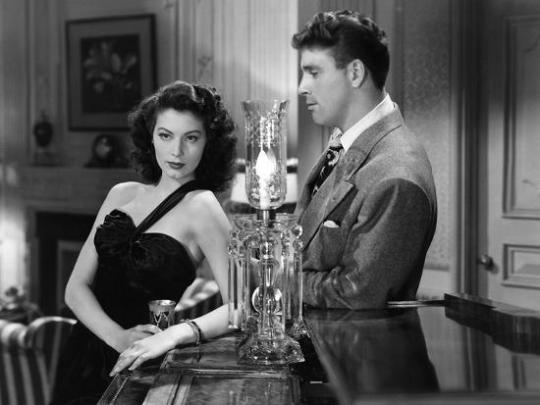
Here's an interesting difference between the Annabel we see in Lenore's memories and the one we see in the present day of the comic: Annabel used to be willing to play by the rules, but the thing she learned from Lenore is that cheating is more than possible. As a result, her attitude has become much closer to that of a Femme Fatale, using her extensive knowledge of the rules to her advantage, going with the flow for personal gain. Her methods are much closer to those of the Hypocrite (especially since we haven't seen Annabel use her body or affection as currency yet), but there are definitely similarities.
Another thing about the Femme Fatale (when she is NOT a villain) is that, like the Vampire, she operates within a duality: an exterior built to be sexy in a somewhat intimidating way (which is why the aesthetics of many of these characters can be interpreted within BDSM culture), but with some goodness in her heart. A really clear example of this is Vivian Sternwood from The Big Sleep (the first novel on the subject published by Raymond Chandler): her own father describes her as "rude, demanding, clever, and quite ruthless," and Marlow, our detective, will have a long series of uncomfortable encounters with her. But by the end of the novel, when he is faced with the same choice Vivian must have made in the past, he cannot help but realize that despite everything, this woman would rather keep painful secrets than harm her family, whom she loves dearly.
So if you're wondering why the framing of scenes like this looks familiar, that's why.


Add to that the three layers of how her aesthetic works: an angelic appearance for when she needs to play dumb, her gaslighting, gatekeeping, girlboss bullshit face for when she needs to demonstrate authority, and framing where it should make you directly uncomfortable.
Looks are one of the strengths of Femmel Fatale's performance. And it's one of the strengths of Annabel's performance.
Conclusions
One interesting thing about looking at Annabel in this light is to realize two things: first, that many of the archetypes her character seems to take notes from are often in the role of antagonists or, for that matter, villains.
The other is that these archetypes are quite well ordered and connected: the gothic vampire is the inspiration for the Femme Fatale of Noir (her beta version, if you can call it that), and the Hypocrite shares a historical writing period with many female vampires. From her conception, Annabel is constructed in a fairly orderly fashion, and believe me, that's a huge contrast to what's going to happen with Lenore (which I'll get to soon, but I need to brush up on my picaresque novel notes).
The last thing I want to point out in this review is this: unless you're a Nick Wilde-style Hypocrite, Hypocrites and Vampires in general tend to have utter destruction in store for them. The Noir, for its part, puts us in a situation where the Femme Fatale, even if she wants to change, is generally too deep in this tangle to get out.
So what I find interesting about Annabel in this regard is:
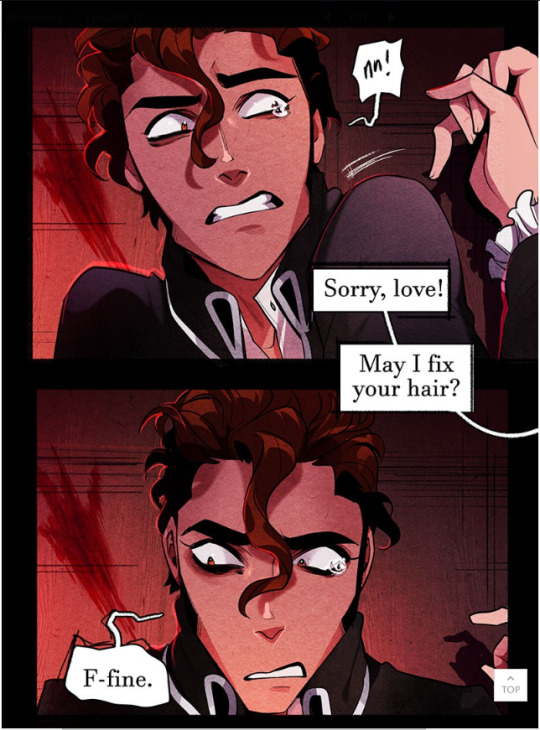
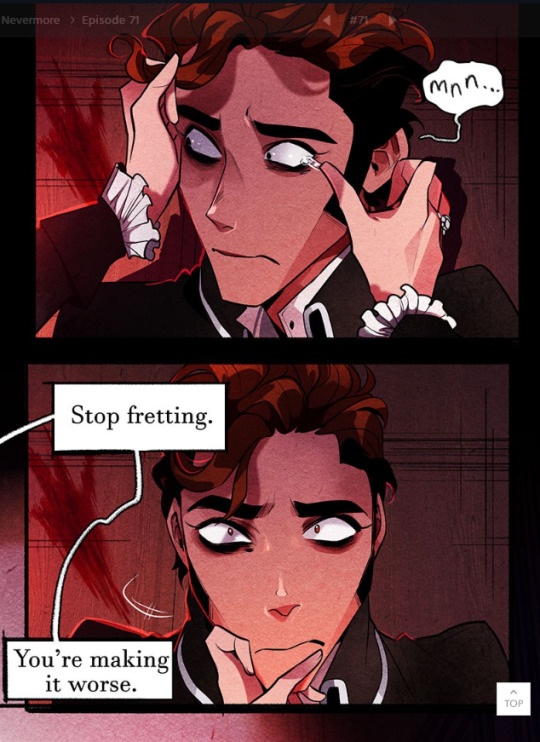
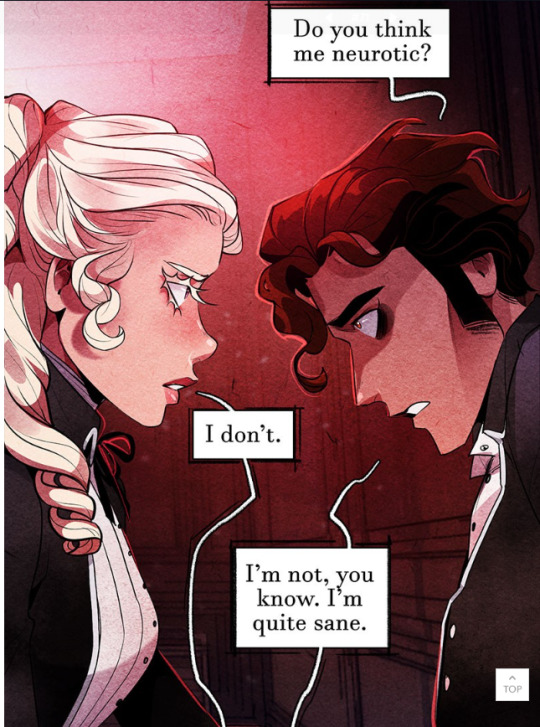
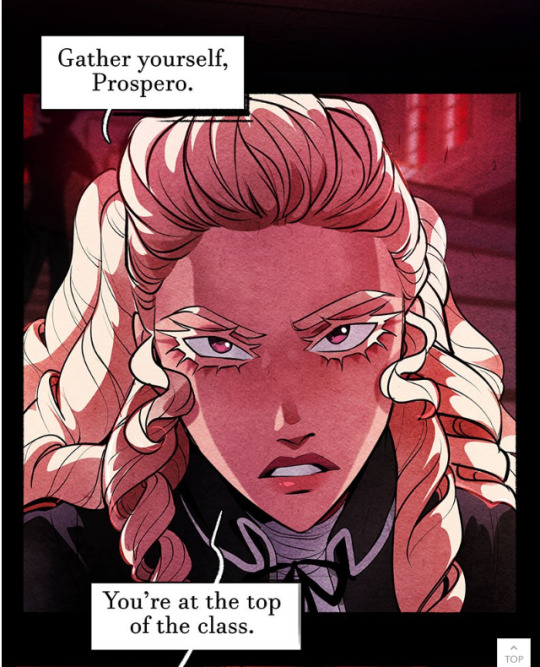

This is actually THE scene that shows us Annabel timidly stepping out of the scheme of things. She doesn't seem to want to change, in fact I'd bet she's terrified to change, but even though she's repeating her father's toxic pattern here, she's also breaking it without realizing it.
It's too early to tell if we'll see Annabel have some sort of redemption towards less harmful behavior, or if we'll end up seeing her become a villain altogether. But I'm really curious to see where this story goes with all of these elements.
118 notes
·
View notes
Text
book 1: mat goes on a homoerotic roadtrip with rand
book 2: mat goes on a second homoerotic roadtrip with rand
book 3: mat goes on a heteroerotic roadtrip to save elayne's life, whilst having occasional homoerotic thoughts about rand
book 4: mat goes on a third homoerotic roadtrip with rand
book 5: mat finishes up his third homoerotic roadtrip with rand
book 6: mat prepares for a polyerotic roadtrip with rand's girlfriends, at rand's request
book 7: mat goes on a polyerotic roadtrip with rand's girlfriends
conclusion: Put Mat In The Polycule, So Help Me God
157 notes
·
View notes
Text


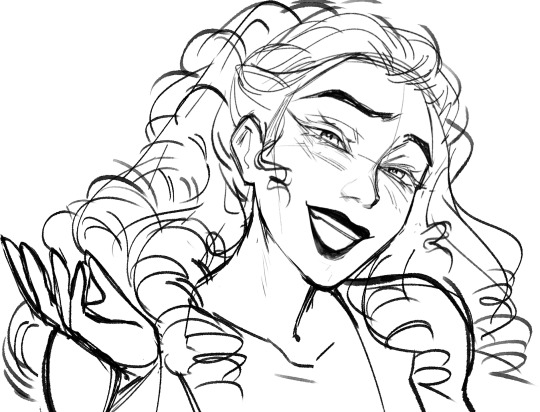





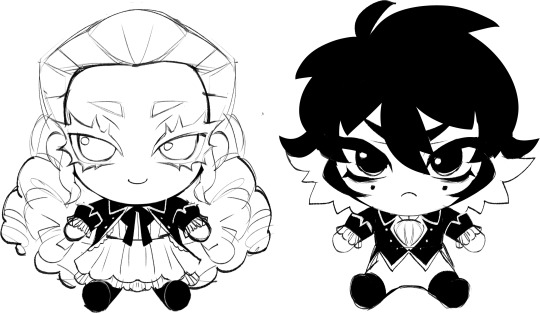
Random Nevermore doodles!!!
2K notes
·
View notes
Text

#my favourite three drama queens#matrandlayne#elayne trakand#rand al'thor#mat cauthon#the wheel of time#wot meme
148 notes
·
View notes
Text
Egwene, Rand, and Mat: *fighting for their lives against Ishamael*
In the distance: Wait, don't do anything yet!
Egwene, Rand, Mat, Ishy stop fighting: Did you hear that?
*A few minutes later*
*Nynaeve, holding onto Elayne, walks up from the stairs*
Elayne: We're here!
Ishamael: What is going on?
Nynaeve: Don't ask her-
Elayne: I am the Daughter-Heir of Andor, and I figured you'd be up here. Hope I didn't miss anything<3
*Nynaeve and Elayne continue to hobble over to the others*
Elayne: Okay, you can keep going!
Egwene and Ishy: *start blasting*
Elayne: *sees Rand* Oh. Hi. *twirls hair* Come here often?
32 notes
·
View notes
Text
The Wheel of Time character types:
The Dumb Puppy - aka - Serial Imprinter - aka - Won't Get A Single Break From Now Until the Final Heat Death of the Universe... Or After.

Tiny and Angry - aka - The Sleeping Berserk Button - aka - The One They're Not Gonna See Coming Until She Rips Out All Their Throats.

'If my middle name wasn't Spite it would be Fuck You' - aka - The Duck Mother to the Very Dumb Baby Ducks - aka - Will Spend at Least an Episode a Season Inside a Tragic Romance B-Plot - aka - Had The Braincell, Temper Made Her Lose It (she contains multitudes).

The Violent Sunshine Character - aka - Would Sucker Punch a God for a Homie She Met Two Hours Ago.
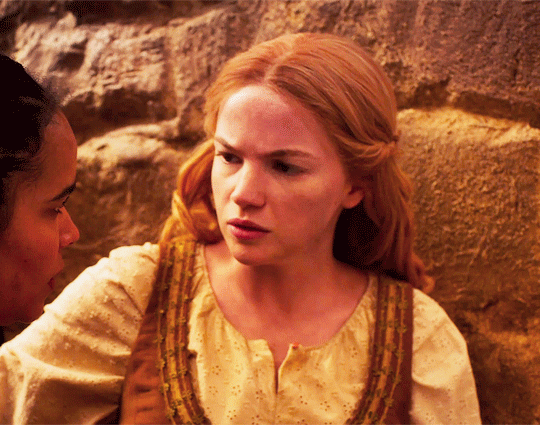
If Evil, Why Hot?

The word 'Nap' isn't in her vocabulary but it should be - aka - Can't Have 'One Nice Thing' for More Than Two and a Half Minutes - aka - Allergic to Feelings.

'There's a big sign that says Don't Touch The Red Button... I'm gonna touch the Red Button.' - aka - Who is This... Self Esteem You Speak Of? Never Heard of Them.

Voted Most Likely to be Adopted by a Hundred Random Strangers - aka - The Wolves Would Like Him to Get the Braincell but it Fell on the Ground and the Ground is Lava.

Doesn't Get Paid Enough for this Shit - aka - Clinging to the Last Braincell With the Tips of His Fingernails - aka - 'I can't believe I of all people am willing to have a single goddamn conversation here.'

'Fine I'll Do the Babysitting But You Owe Me So Much Booze' - aka - The Aunt That Once Forgot You In the Mall - aka - The Aunt That Gave You All the Safe Sex Tips and Traumatized You For Life - aka - The Aunt That Would Absolutely Bury a Body No Questions Asked.

#IM ON THE FLOOR#rand al'thor#egwene al'vere#nynaeve al'meara#elayne trakand#lanfear#moiraine damodred#mat cauthon#perrin aybara#al'lan mandragoran#alanna mosvani#the wheel of time#wot meme
1K notes
·
View notes
Text
Elayne really pulled the “I’m the daughter-heir and I’ve trained my whole life for this, I know what I’m doing” card to Nynaeve and her plan was just
bonk
185 notes
·
View notes
Text
guys help i'm running out of space
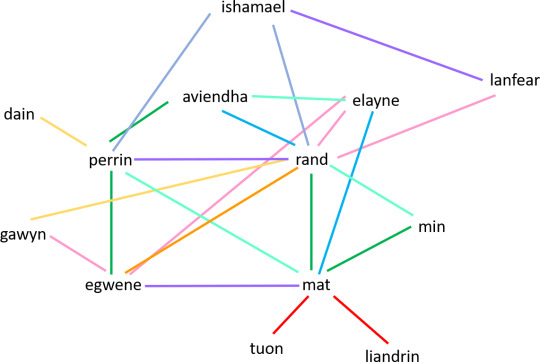

454 notes
·
View notes
Text

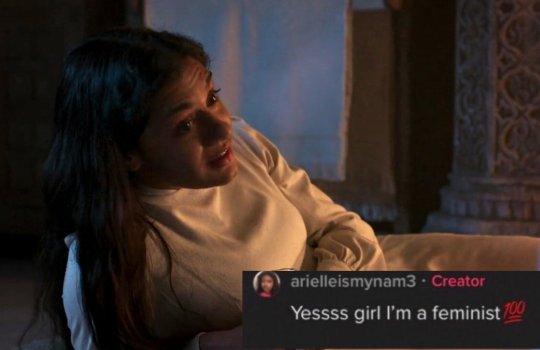
Egwene, that wasn't what Elayne meant xD
617 notes
·
View notes
Text


THE WHEEL OF TIME | 2x04
#my babies#when they meet I will combust on the spot#randlayne#the wheel of time#elayne trakand#rand al'thor
197 notes
·
View notes
Text
Rand Al'Thor in The Shadow Rising:

22 notes
·
View notes
